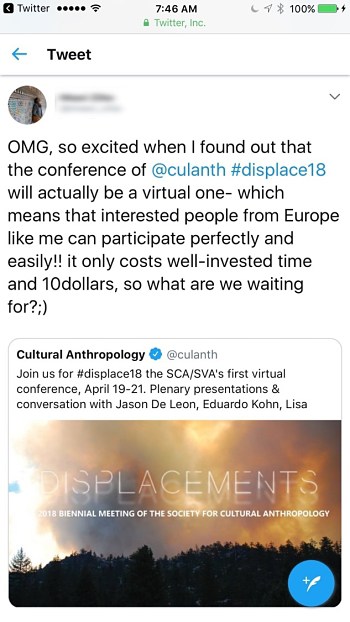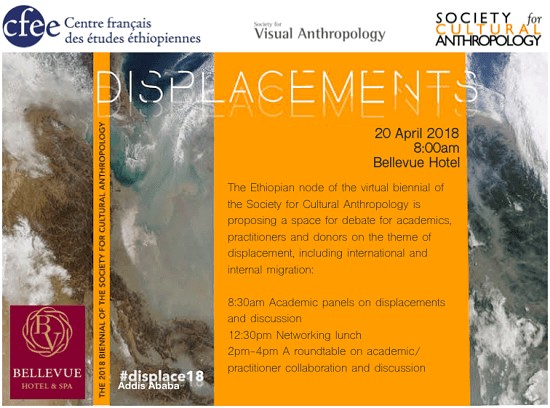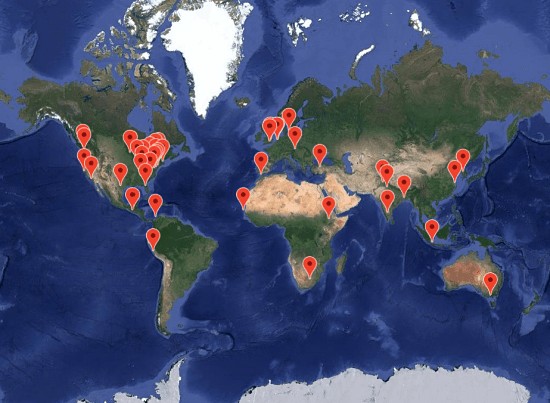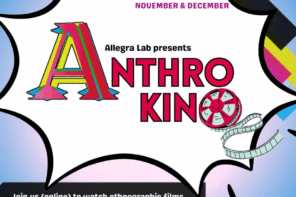The Society for Cultural Anthropology is experimenting with a new exciting initiative this year. Next week (19-21 April 2018) the Biennial Meeting will take place online, as a virtual conference. We are excited to offer you a sneak preview of what is to come. Allegra spoke to one of the conference organizers, Anand Pandian.
Liina Mustonen (LM): This year’s SCA Biennale meeting under the title “Displacements” will take place as a virtual conference – meaning no air travel, no hotel costs and hence no carbon pollution. Would you like to tell our readers how you came up with such a fantastic experimentation? What made you decide to organize a virtual conference?
Anand Pandian (AP): There are three reasons we had in mind. First, indeed, conference travel is one of the most significant carbon footprints for scholars and academics, sometimes involving millions of collective miles of carbon-fueled travel for everyone to reach one place. Second, we are thinking about equitable access: the fact that many people can’t afford such travel, and that many others can’t do it in a time of greater travel bans and restrictions, especially here in the United States. And third, we’ve been thinking about the odd experience that one often has as an anthropologist, trying to give some immersive and evocative sense of a distant place while standing and talking in the midst of an ornate hotel ballroom or bland corporate conference center. If we gave presenters the chance to craft their presentations as audiovisual artifacts, could this mode of presentation actually be more immersive and engaging than a conference talk, rather than less so? We were very gratified to see the rich visual and multimedia experience conjured by the presenters in this conference, work so interesting that we knew we needed a conference trailer!
#displace18 Conference Trailer from Cultural Anthropology on Vimeo.
LM: There is a good amount of information about the technical side of the conference on the conference webpage, but for those of our readers who didn’t have time to look at it yet, would you like to give us a briefing? How does it work? How can I participate?
AP: The conference will be hosted, located, if you will, at displacements.jhu.edu between April 19-21, 2018. If you land on the page, you will find a video welcome and introduction, and an invitation to register for the event for a nominal fee of just $10 USD. When you register and log in, you will find yourself, for those three days, immediately faced with a conference livestream, which will be playing pre-recorded conference panels and presentations continuously over nearly 60 hours, as if this were a television channel for conference participants alone. You can watch what is “on” at a given time, in the company of everyone else who is watching what is happening at that time. Or, if you choose, you can go instead to an individual panel page to watch whatever presentation you might like to see at that time. Each of these panel pages will go “live” only after they have been “released” on the conference livestream. The idea here is to give some sense of liveness and excitement at the appearance of something new. Once a panel page goes live, it will remain available throughout the conference, as will the stream. One of the most exciting sessions will be the David Schneider Memorial Plenary, featuring powerful new work in ethnographic film and photography by the anthropologists Eduardo Kohn & Lisa Stevenson, Jason De Leon, and Stephanie Spray.
LM: In particular, I am interested how you facilitate discussions and exchanges between speakers and the audience? For example the roundtable consists of a number of speakers – how do you facilitate the conversation?
AP: We recognize that people attend conferences not just to hear presentations but also to interact and discuss and socialize. We have been working very hard at building multiple channels for such dialogue and interaction into the conference experience. The livestream will be accompanied by a chat box in which participants can react and discuss in real time as the presentations follow one on another. The panel pages will allow for threaded conversations in response to the presentations on each specific panel, and presenters have been asked to attend to these threads and respond in as timely a manner as possible to the questions and ideas raised. We are encouraging people to use social media like Twitter and Instagram (#displace18) to share their thoughts and reactions not only with each other but also with broader and more dispersed publics. We will also have a separate user experience page on the website to allow people to respond to the experience in a more open-ended and freeform style, as this is an experimental and evolving form and we are also trying to figure out, as we go along, what is working well, and what isn’t.
LM: SCA and its publication Cultural Anthropology has been very innovative in the field of academic publishing, making anthropology accessible to broader audiences. I see that the “Displacement” conference is a continuum of that spirit. Do you see this as a model for future conferences?
AP: SCA and Cultural Anthropology have been spaces for experimentation in anthropology, both with regard to argument and form as well as with regard to access and distribution. I see this endeavor as an extension of that spirit of open-access publishing into another realm of scholarly production and dissemination. We are also very excited to partner in this venture with the equally innovative Society for Visual Anthropology, who have curated for the conference a fantastic festival of contemporary ethnographic films. We have not been able to sponsor the conference for free, most essentially because there are many very talented and committed people devoted to this endeavor and their labor must be compensated. But, in setting the registration fee at this low rate, we are hoping to broaden the audience. If there is scope for such ventures in the future (we are inspired by previous efforts of this kind, and I hope personally that there will be many more), I think that there are more things that can be done. We have built disability access into the design of the conference, for example, but it takes place only in English, and a future attempt could work to bring other languages into the framework. We have an amazing team of 25 people who have been working very hard on this conference, improvising so many strategies and ideas day by day, and we hope that many more such experiments will come, as they must.

AP: You’re absolutely right. The Biennial has tended to be a smaller, and more regional event. This one is much more international in scope. We are proud to say that we have presentations from scholars based in 21 countries, based on research undertaken in 46 different countries around the world. People have registered to attend from many more countries. And many have said that they appreciate the possibility of attending the conference from their homes in other countries far from North America, because of the online format. Here’s a tweet that attests to that.
LM: I would like to talk a little bit about the theme of the conference. The theme “Displacements” is a reflection of our time and perhaps our positionality as anthropologists. When you began designing the conference, did you see a connection between the two – the conference title and the format?
AP: Yes, certainly. Displacements of many kinds – social, political, transnational, environmental – are an essential feature of the present moment, and the subject of much concern in public discourse and for anthropologists more specifically; the presenters have very powerful and important things to say about this topic. It is also the case that anthropology itself is founded on the creative and imaginative promise of displacements, as a matter of method: going elsewhere, effecting transformations in the experiential texture of the here-and-now through the introduction of ethnographic distance and perspective. When it came time to think of a theme appropriate for this first attempt at a virtual conference, this made sense in both thematic and methodological terms. We are asking you to “displace yourself” into another mode of engagement.
LM: Besides being a fantastic environmental conscious initiative that forces us scholars to think about our own ecological footprints, I wonder whether the conference format and the conference theme also speak to the contemporary precarity in the disciplines of humanities in general and anthropology in particular?
AP:This is an essential topic that all of us must acknowledge and grapple with. And it was very much on our minds with this conference design. Are academic disciplines asking too much of graduate students, new PhDs, adjunct instructors and others, to spend thousands of dollars to fly somewhere for a conference, stay for a few days, pay expensive registration fees and wait and hope for the chance that someone influential will have a sympathetic ear or a job to offer? Is this the only way to proceed? And then think of that sense of disappointment when you put all this time and money into a conference presentation only to find it scheduled at 8am on a Sunday morning and hardly anyone in the room aside from the panelists themselves. A platform like ours, if enough people commit to the idea, could be effective at building audiences for the hard work that anthropologists do in the face of precarity. Face-to-face relationships and conversations will remain essential to employment prospects, but we are hoping to show that one can build other channels for the sharing of new research and the building of intellectual communities. Online blogs and networks like Allegra and many others have shown us this, and we are following your lead into the digital realm.
LM: Addis Ababa, Ankara, Bangalore, Irvine, New York, Tangier – an impressive list of local “nodes” are mentioned on the conference website. Would you like to explain us how “nodes” are utilized in the conference? How do the “nodes” facilitate participation? Is it still possible to create one’s own “node”?
AP: We hope that this conference experience will amount to something more than each individual spending several days on their own, staring into one digital screen or another. We are hoping that the material that we broadcast online can feed into existing networks of relationship and conversation, or serve as an impetus to encourage the formation of other such collective relations. The “nodes,” therefore, are an essential aspect of the conference vision: we are encouraging people to get together to watch some of the presentations, and to take a break now and then to chat, converse, argue, and discuss. It has been amazing to see the proliferation of local sites on our node map, to try to imagine the idea that this conference will “happen” in all these scattered places at once.
We conceive the nodes as two-way channels. They are occasions for collective uptake of what is being broadcast through the conference website, but they are also sites for their own independent conversations, discussions, workshops, and so on, which can be brought into the space of the conference via the node map if local organizers wish to do so. Here, for example, is a poster we received from the Addis Ababa node:

Poster by Anais Maro (French Centre for Ethiopian Studies)
We are grateful to the Wenner-Gren Foundation for sponsoring the organization of a number of such nodes in the global South, and this, I think, is one of the most interesting and important developments to come from this process. Could this kind of conferencing be a way to lessen the gap between those out-of-the-way places in which anthropologists often work and the powerful metropolitan centers where they share that work? Where all of this goes, we will have to see. In fact, if anyone reading this would like to organize a local conference node, get in touch with us via displacements@culanth.org and let’s try to make it happen.
Please register and tune in next week, as we find out how this goes!
Featured image (cropped) by Carla Antonini (Wikimedia Commons, CC BY-SA 3.0)











